Honor Award
Canals as Greenways
Paul Toenjes, Student ASLA and Shuntaro Yahiro, Student ASLA, Graduate, Lousianna State University
Faculty Advisor: Lake Douglas, ASLA
 Close Me!
Close Me!Master Plan / Process of Water Diversification
Download Hi-Res ImageImage: Paul Toenjes and Shuntaro Yahiro
Image 1 of 15
 Close Me!
Close Me!Site Location /3 Main Goals of the Project
Download Hi-Res ImageImage: Paul Toenjes and Shuntaro Yahiro
Image 2 of 15
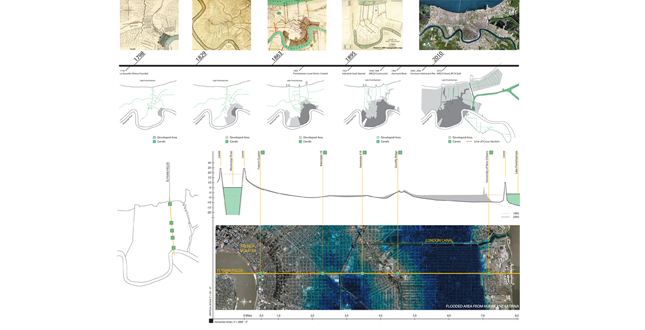 Close Me!
Close Me!Growth of the City of New Orleans with Canals / Section of the City and Emphasis on Subsidence. The city was constantly under the threat of flooding, not only due to the water bodies around it, but due to large rainstorms common to the area. Over the last 100 years, areas of the city, particularly near the Lake, have sunk between 5 and 10 feet.
Download Hi-Res ImageImage: Paul Toenjes and Shuntaro Yahiro
Image 3 of 15
 Close Me!
Close Me!Problems and Possibilities. The canals provide a multitude of possibilities, becoming community amenities. As part of a green network, the canals could serve to connect communities, while becoming part of a safer and more diversified system.
Download Hi-Res ImageImage: Paul Toenjes and Shuntaro Yahiro
Image 4 of 15
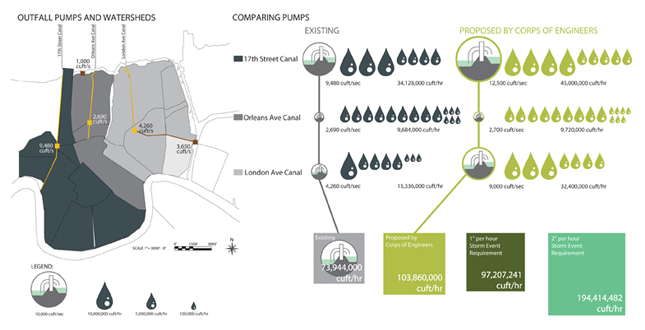 Close Me!
Close Me!Existing Pumps V.S. Proposed and The Problem of the 2" Storm. Existing pumping capacity is insufficient. These pumps are overwhelmed after 4 hours of rain at 1 inch per hour. The proposed pumps are not significantly better, having only slightly larger capacity than required for 1 in of constant rain.
Download Hi-Res ImageImage: Paul Toenjes and Shuntaro Yahiro
Image 5 of 15
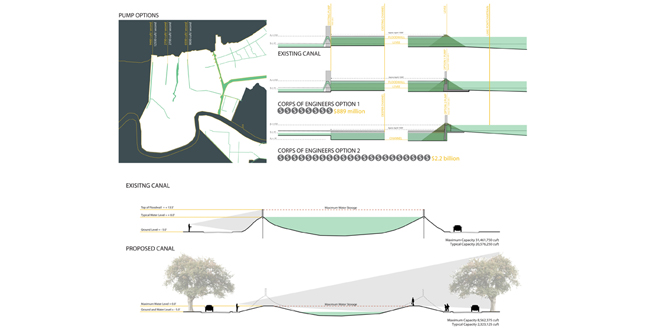 Close Me!
Close Me!Existing Canal and Pump Section V.S. Corps of Engineers Proposed / Comparison of Existing Canal Section and Proposed Canal. Along the three major outfall canals for the city, water is elevated lake level far inland, nearly two miles in fact, requiring vulnerable floodwalls. Diversification allows floodwalls to be removed and levees to be reduced, reconnecting neighborhoods.
Download Hi-Res ImageImage: Paul Toenjes and Shuntaro Yahiro
Image 6 of 15
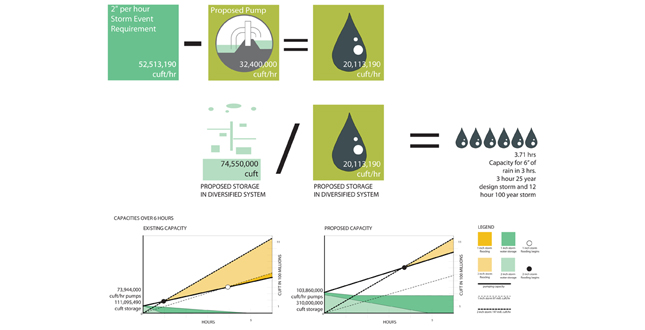 Close Me!
Close Me!Summary of the Water Stage Capacity of System / Graph Comparing Existing and Design System. Pumps can only move so much water, and the remainder must be stored in the system until the pumps can catch up with rainfall. The diversified system creates enough storage for the first 3.71 hours while 2" per hour is falling.
Download Hi-Res ImageImage: Paul Toenjes and Shuntaro Yahiro
Image 7 of 15
 Close Me!
Close Me!Axonometric Comparison of Existing V.S. Proposed Diversified System. The existing canal system is comprised of underground drainage which is pumped into the canals and then to the level of the lake. The diversified system includes a pump/barrier at the lake, and spreads water storage to adjacent neighborhoods.
Download Hi-Res ImageImage: Paul Toenjes and Shuntaro Yahiro
Image 8 of 15
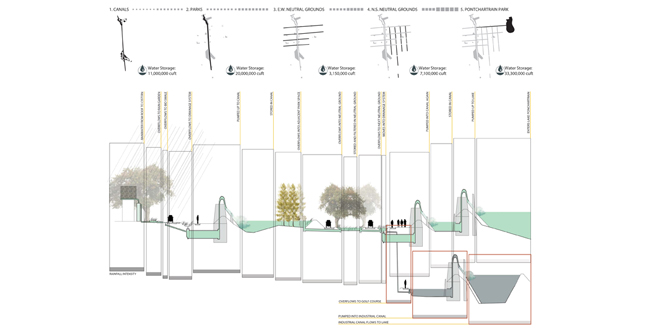 Close Me!
Close Me!Process of Water Diversification / Proposed System Section: From House to Canal. Initial rainfall is captured and infiltrated, excess runoff enters subsurface drainage. As the canal reaches capacity, water spreads into park spaces, neutral grounds, and other sites. Much of the water is infiltrated, while excess is eventually returned to the canals.
Download Hi-Res ImageImage: Paul Toenjes and Shuntaro Yahiro
Image 9 of 15
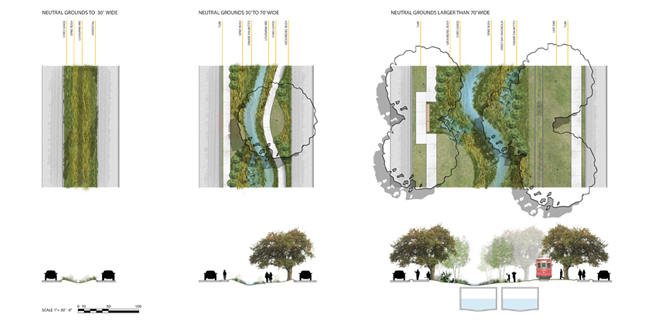 Close Me!
Close Me!Proposed Neutral Grounds Plans and Sections. Beneath many neutral grounds (boulevard medians), large box culverts hide forgotten canals. Water from here is carried to the pumping stations and into the canals. By regarding these neutral grounds, we create surface water storage for canal overflow and infiltration.
Download Hi-Res ImageImage: Paul Toenjes and Shuntaro Yahiro
Image 10 of 15
 Close Me!
Close Me!Proposed Neutral Grounds Perspective. At an existing commercial area in Gentilly, water is brought into the site, and becomes an impetus for economic growth. As part of the redesign, the streetcar is brought into the area, allowing residents to move easily to downtown.
Download Hi-Res ImageImage: Paul Toenjes and Shuntaro Yahiro
Image 11 of 15
 Close Me!
Close Me!Plan, Diagrams and Section for University of New Orleans. Connections to the University of New Orleans would bring the University to the water, while accommodating 7.7 million cubic feet of water. Multi-use spaces are formed along the canal sloping down to the water, and an ecological edge is created.
Download Hi-Res ImageImage: Paul Toenjes and Shuntaro Yahiro
Image 12 of 15
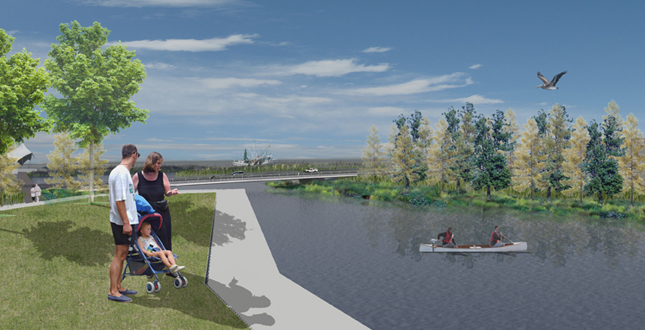 Close Me!
Close Me!Perspective for University of New Orleans. University of New Orleans is linked to the lakefront along a more naturalistic canal. A long pier extends to constructed islands which protect the outfall of the canal and the pumping station from waves generated during storm surge.
Download Hi-Res ImageImage: Paul Toenjes and Shuntaro Yahiro
Image 13 of 15
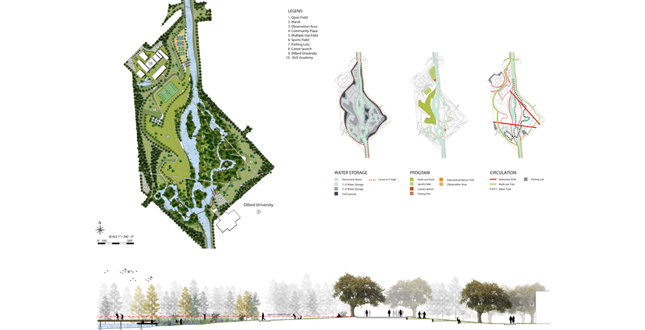 Close Me!
Close Me!Plan, Diagram and Section for Dillard University. A large vacant lot along the canal can store nearly 8.5 million cubic feet of water, while creating a dynamic park. Akill Academy and Dillard University become part of a park along with canal with a multitude of outdoor opportunities.
Download Hi-Res ImageImage: Paul Toenjes and Shuntaro Yahiro
Image 14 of 15
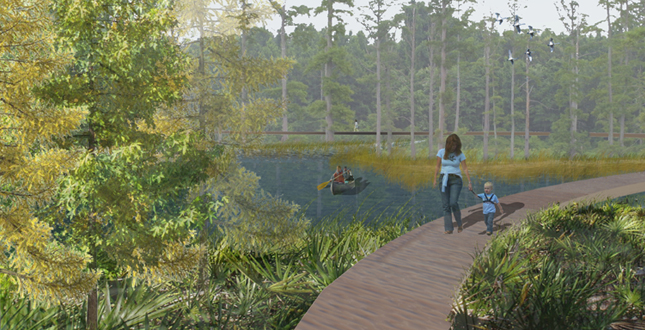 Close Me!
Close Me!Perspective for Dillard University. The Dillard University side of the canal becomes and nature education area, providing observation areas, fishing and canoeing.
Download Hi-Res ImageImage: Paul Toenjes and Shuntaro Yahiro
Image 15 of 15
Project Statement
Taking the vast expense of a large infrastructural project and turning it into an amenity can be achieved through distributing the infrastructure throughout the community. It is possible to create a resilient canal system for New Orleans which deals with water storage throughout the city, creating a green network through which the community can be redefined. Each infrastructure piece has the potential to be beautiful, have significant economic impact and provide much needed greenspace.
Project Narrative
—2011 Student Awards Jury
Reenvisioning the Canals: Canals as Greenways
An understanding of the setting of New Orleans, its drainage system and rainstorms, and its neighborhoods was vital to redesigning the canal system. To achieve the goals of the project, the most important step is removing the vulnerable and obtrusive concrete floodwalls. These floodwalls are a significant risk to the city, allowing water in the canals to be raised to levels that are significantly higher than the surrounding homes while exhibiting their vulnerability in the face of storm surge. In addition, canals are cutoff from surrounding neighborhoods. Neighbors cannot see the water, and, in many cases, cannot cross the canals for distances up to a mile.
Though New Orleans is surrounded by water, water is not a part of everyday life. Neighborhoods built along surface level canals, such as the Bayou St. John neighborhood in New Orleans have been extremely successful. The surrounding neighbors use the canal as a linear park (though it is not designated as one) and canoes are tied up in front of many residences.
Drainage, Flooding and Failures
Surrounded by Lake Pontchartrain, the Mississippi River, swamps and marshes, New Orleans' location made for an ideal port city. However, the city was constantly under the threat of flooding, not only due to the water bodies around it, but the lack of topography combined with the intense rainstorms common to the area. Canals solved the drainage problem and made easy transportation connections to the shore of the lake.
In New Orleans, water drains north to the lake. Low-lying swampland between the city and the lake remained mostly unchanged until the early 1900s, but as the city grew development was stymied by a lack of buildable land. A levee at the lake and the addition of pumps along the canals allowed large areas to be drained and developed. However, the process of draining the swamps had a negative impact on groundwater in the area. Canals which were dug out of the landscape filled with groundwater as well as rainwater, which, as this water was removed, the water table fell and the land began to sink and subside.
The unconsolidated organic peats and soils of the area started to break down in the absence of water. Thus, over the last 100 years, areas of the city, particularly near the Lake, have sunk between 5 and 10 feet. Areas once above the water level now sit nearly 5 feet below, and drainage pumps are the only solution to getting the water out of the city.
The levee along the lake which made development possible also created the “bowl” that New Orleans now sits in. It protects the city from storm surge, but pumps must lift water from the canals over it and into the lake. However, the location of the pumps weakens the system. Along the three major outfall canals for the city, 17th Street, Orleans Avenue, and London Avenue canals, canal water is elevated to the level of the lake far inland, nearly two miles in fact. Storm surge during Hurricane Katrina was able to move all the way in to these pumps before reaching an obstruction. When it did, the pressure caused major levee breaches in the concrete I-walls along the canals.
Addressing the Problem with the Same Solutions
The current outfall pumps have to move vast amounts of water. Five main pump stations are responsible for the majority of the city's drainage, a watershed of over 40 square miles of the city. Existing pumping capacity is insufficient. These pumps are overwhelmed after 4 hours of rain at an average intensity of 1 inch of per hour, not uncommon in New Orleans. Regular flooding caused by backups in the system is quite common. Also, power outages can take these pumps offline instantly.
An option proposed by the Army Corps of Engineers to improve the situation focuses on the construction of new pumps at the Lake's edge, which would serve as a storm surge barrier as well. But, it still relies on vulnerable concrete floodwalls. In a second option canal water levels can remain considerably lower, allowing the removal of floodwalls along canals. However, this option includes complete regrading and reconstruction of the three main canals, and has already been deemed highly unlikely by congressional appropriations members.
Option one fails after an hour of rain at a rate of 2 inches per hour. Option two does not fare much better. Though redesigning and rebuilding the canals makes them safer and can create 11.5 million cubic feet additional storage capacity, the system is still overwhelmed in 1 hour. This is particularly a problem because much of the rainfall in a storm event in New Orleans comes in the first few hours, sometimes with up to 4 inches of rain in an hour. Since the existing and proposed canal systems rely almost completely on pumps and are insufficient, creating more water storage capacity in the system is vital to any design solution.
The Diversified System
Canals become the central part of a system that captures rainwater where it falls and stores it throughout the community, energizing neighborhoods and bringing natural areas to underdeveloped communities. Connected cisterns, rain gardens, parklands, neutral grounds (known as medians elsewhere), vacant land, and canals take stress off of the pumps and greatly reduce the risk of flooding. At the same time, canal walls can be lowered and access can be provided to the water.
This design strategy focuses on the London Avenue Canal, the site of two major breaches during Katrina, but can be generalized to the other outfall canals in New Orleans and Jefferson Parish. GIS analysis found there significant amount of vacant property near the canals, and many small underutilized parks and neutral grounds nearby which could be consolidated into the system. In addition, this area has been slow to recover from the hurricane and is in need of an impetus for redevelopment.
Essentially the diversified system has five pieces. Water first fills the canals. This water overflows into parklands adjacent to the canal and into other parklands. From here water moves into the east-west neutral grounds which radiate out from the canal. In turn, these neutral grounds connect into north-south neutral grounds. The last step is an emergency overflow scenario, where water floods Pontchartrain Park and is moved by auxiliary pump into the Industrial Canal. As rainfall subsides, the pumps can begin to remove the excess water from the underground system, and the surface water that has not infiltrated into the ground can begin to flow into the traditional underground system.
Changing the configuration of the canals greatly impacts the volume of storage in them, the diversified system is able to create capacity to store water during the first 3.71 hours while rain falls consistently at 2 inches per hour. This is equivalent to the capacity needed for the major downpour at the beginning of a 100 year design storm.
Implementation
Federal FEMA dollars as well as the resources of the Army Corps of Engineers are expected to fund current proposals for redesigning the canals in New Orleans, as they have funded many of the levee updates currently underway in the city. As this proposal looks at an alternative which would be of similar cost, but with much broader reaching implications and benefits, the same funding sources and implementation would be expected.
Additional Project Credits






